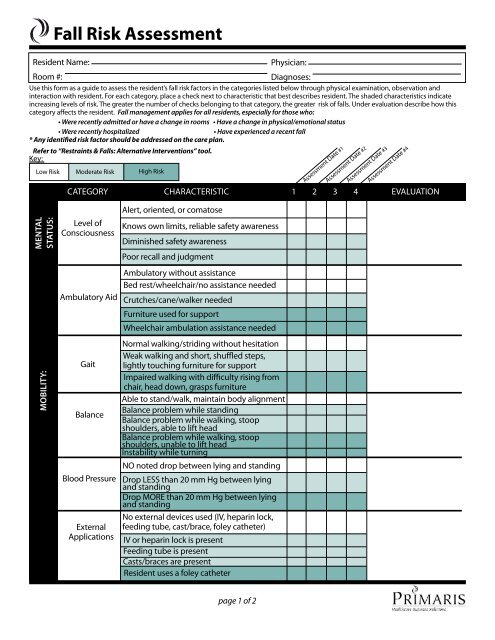Unknown Facts About Dementia Fall Risk
Table of ContentsAn Unbiased View of Dementia Fall RiskA Biased View of Dementia Fall RiskOur Dementia Fall Risk StatementsFacts About Dementia Fall Risk RevealedThe Main Principles Of Dementia Fall Risk
In the area, inadequate road illumination or vulnerable creeks and garbage dumps may additionally create mishaps. Falls Threat Evaluation Tool (FRAT) is a 4-item falls-risk testing tool for sub-acute and household care. The FRAT has three areas: drop threat status, risk aspect checklist, and activity plan. An Autumn Risk Standing consists of data regarding background of recent drops, medications, mental and cognitive status of the client.If the patient scores on a threat variable, the corresponding number of factors are counted to the client's loss danger rating in the box to the far best. If a patient's loss threat rating totals 5 or higher, the person goes to high risk for falls. If the person ratings only four points or lower, they are still at some threat of dropping, and the nurse needs to use their finest medical assessment to manage all autumn danger aspects as component of an alternative care plan.
These conventional strategies, in basic, assist create a safe setting that lowers accidental falls and delineates core preventive steps for all clients. Signs are essential for clients at risk for drops.
The Only Guide for Dementia Fall Risk
Wristbands ought to consist of the patient's last and initial name, date of birth, and NHS number in the UK. Details need to be printed/written in black versus a white history. Only red color should be used to indicate unique person status. These recommendations are consistent with present developments in client identification (Sevdalis et al., 2009).
Items that are as well much might require the individual to connect or ambulate needlessly and can possibly be a risk or add to falls. Aids prevent the patient from going out of bed without any type of help. Registered nurses react to fallers' call lights quicker than they do to lights started by non-fallers.
Visual disability can considerably create drops. Hip pads, when put on effectively, may lower a hip crack when fall happens. Maintaining the beds closer to the floor reduces the threat of falls and major injury. Placing the cushion on the floor substantially decreases fall risk in some health care settings. Reduced beds are made to lessen the range a client falls after moving out of bed.
What Does Dementia Fall Risk Mean?
Patients who are high and with weak leg muscles who attempt to rest on the bed from a standing position are most likely to drop onto the bed since it's also reduced for them to reduce themselves securely. If a high patient attempts to get up from a low bed without help, the client is most likely to drop back down onto the bed or miss out on the bed and drop onto the flooring.
They're designed to promote prompt rescue, not to stop falls from bed. Distinct alarm systems can likewise advise the client not to stand up alone. Using alarms can likewise be a replacement for physical restraints. Apart from bed alarm systems, enhanced guidance for risky people additionally might assist protect against drops.

People with check over here an evasion gait rise fall chances substantially. To minimize fall risk, footwear need to be with a little to no heel, thin soles with slip-resistant step, and support the ankles. Advise individual to utilize nonskid socks to stop the feet from gliding upon standing. Nonetheless, motivate clients to wear proper, well-fitting shoesnot nonskid socks for motion.
The 5-Second Trick For Dementia Fall Risk
Patients, especially older adults, have reduced aesthetic capability. Lighting an unknown setting aids enhance presence if the client need to stand up at evening. In a study, homes with appropriate lighting record less drops (Ramulu et al., 2021). Enhancement in lights in your home might lower fall rates in older grownups (Dementia Fall Risk). Making use of stride belts by all health care service providers can promote security when aiding patients with transfers from bed to chair.

Sitters work for guaranteeing a safe, secured, and risk-free setting. However, researches showed very low-certainty proof that caretakers lower loss threat in intense care hospitals and just moderate-certainty that choices like video clip tracking can minimize caretaker use without boosting autumn risk, suggesting that sitters are not as helpful as at first believed (Greely et al., 2020).
Our Dementia Fall Risk PDFs

Raised Go Here physical fitness lowers the risk for drops and limits injury that is sustained when loss transpires. Land and water-based workout programs may be in a similar way beneficial on equilibrium and gait and consequently decrease the threat for falls. Water workout might add a positive benefit on balance and stride for women 65 years and older.
Chair Increase Workout is a simple sit-to-stand workout that helps reinforce the muscles in the upper legs and butts and improves flexibility and freedom. The goal is to do Chair Increase workouts without making use of hands as the customer comes to be stronger. See resources area for a thorough instruction on exactly how to do Chair Increase exercise.